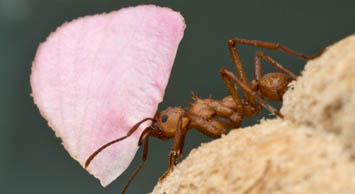Discovering novel drugs in unexpected places

PhD student Eleni Vikeli from the John Innes Centre (JIC) is part of a team of researchers working on exploring new environments to uncover novel antibiotics to help in the fight against antimicrobial resistance.
PhD student Eleni Vikeli from the John Innes Centre (JIC) is part of a team of researchers working on exploring new environments to uncover novel antibiotics to help in the fight against antimicrobial resistance.
With disease causing bacteria becoming multidrug resistant, scientists at the University of East Anglia (UEA) and the JIC are examining underexplored environments such as the deep sea and leafcutter ant nests in the hope they will provide us with the next generation of antibiotics.
Most of our antibiotics are “natural products” made by a group of bacteria called actinomycetes that live in the soil. But when soil bacteria produce these antibiotics they also express resistance genes, to protect them against the antibiotic’s toxic effects.
Unfortunately, these resistance genes have spread to other “bad” bacteria, causing antibiotic-resistant strains to evolve which current antibiotics are powerless to treat.
The research is focused on discovering novel antibiotics made by the actinomycete bacteria that live on leafcutter ants. Leafcutter ants are also being used to try and understand how animals form symbioses with beneficial bacteria.
Led by Dr Matt Hutchings from UEA’s School of Biological Sciences with Prof Barrie Wilkinson, a natural product chemist at the JIC, the ant project will research how host animals select good, antibiotic-producing bacteria and keep out the bad. This is one of the most important questions in biology, because a healthy microbiome is essential for the host’s survival and may also lead to the discovery of new antibiotics.
Photo credit: Matt Hutchings, University of East Anglia
